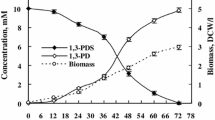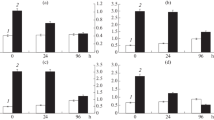Summary
Newly isolated and already available strains of alkene-utilizing bacteria were able to oxidize ethene, propene or 1-butene to the respective 1,2-epoxides. Resting-cell suspensions of organisms isolated on propene and butene, when grown on these substrates converted ethene quantitatively to epoxyethane. Some, but not all ethene-utilizing strains accumulated 1,2-epoxypropane or 1,2-epoxybutane when propene or butene was supplied, although not quantitatively because the epoxides produced were partially further metabolized. Suitable epoxide producers which eventually may be employed as biocatalysts in a biotechnological process were used for immobilization in calcium alginate and K-carrageenan; after immobilization, 60%–100% activity for epoxide production was retained.
Similar content being viewed by others
References
Abbot BJ, Hou CT (1973) Oxidation of 1-alkenes to 1,2-epoxyalkanes by Pseudomonas oleovorans. Appl Microbiol 26:86–91
Bont de JAM (1976) Oxidation of ethylene by soil bacteria. Antonie van Leeuwenhoek 42:59–71
Bont de JAM, Harder W (1978) Metabolism of ethylene by Mycobacterium E20. FEMS Microbiol Lett 3:89–93
Bont de JAM, Attwood MM, Primrose SB, Harder W (1979) Epoxidation of short-chain alkenes in Mycobacterium E20: the involvement of a specific mono-oxygenase. FEMS Microbiol Lett 6:183–188
Bont de JAM, Primrose SB, Collin MD, Jones D (1980) Chemical studies on some bacteria which utilize gaseous unsaturated hydrocarbons. J Gen Microbiol 117:97–102
Bont de JAM, Tramper J, Luyben KChAM (1981) Production of propylene oxide by immobilized Mycobacteria. In: Abstracts of Communications. Second European Congress of Biotechnology, Eastbourne, p 158
Bont de JAM, Ginkel van CG, Tramper J, Luyben KChAM (1983) Ethylene oxide production by immobilized Mycobacterium Py1 in a gas-solid bioreactor. Enzyme Microbiol Techn 5:55–60
Cardini G, Jurtshuk P (1970) The enzymatic hydroxylation of n-octane by Corynebacterium sp strain 7ELC. J Biol Chem 245:2789–2796
Furuhashi K, Taoka A, Karuba I, Suzuki S (1981) Production of 1,2-epoxy alkanes from 1-alkenes by Nocardia corallina B-276. Eur J Appl Microbiol Biotechnol 12:39–45
Higgins IJ, Hammons RC, Saraislani FS, Best DJ, Davies MM, Tryhorn SE, Taylor F (1979) Biotransformation of hydrocarbons and related compounds by whole organisms of Methylosinus trichosporium OB3b. Biochem Biophys Res Commun 89:671–677
Higgins IJ, Best DJ, Hammons RC (1980) New findings in methane-utilizing bacteria highlight their importance in the biosphere and their commercial potential. Nature 286:561
Hou CT, Patel RN, Laskin AI, Barnabe N (1979) Microbial oxidation of gaseous hydrocarbons: epoxidation of C2 to C4 n-alkenes by methylotrophic bacteria. Appl Environ Microbiol 38:127–134
Hou CT, Patel RN, Laskin AI (1983) Epoxidation of short-chain alkenes by resting-cell suspensions of propane-grown bacteria. Appl Environ Microbiol 46:171–177
Linden van der AC (1963) Epoxidation of olefins by heptane-grown Pseudomonas cells. Biochim Biophys Acta 77:157–159
Parkinson G (1980) Enzyme path to products is traced at meeting. Chem Eng 87:37–39
Patel RN, Hou CT, Laskin AI, Felix A, Derelanko P (1983) Epoxidation of n-alkenes by organisms grown on gaseous alkanes. J Appl Biochem 5:121–131
Smet de MJ, Wynberg H, Witholt B (1981) Synthesis of 1,2-epoxyoctane by Pseudomonas oleovorans during growth in a two-phase system containing high concentrations of 1-octene. Appl Environ Microbiol 42:811–816
Smet de MJ, Kingma J, Wynberg H, Witholt B (1983) Pseudomonas oleovorans as a tool in bioconversions of hydrocarbons: growth, morphology and conversion characteristics in different two-phase systems. Enzyme Microbiol Techn 5:352–360
Stirling DI, Dalton H (1979) The fortuitous oxidation and co-metabolism of various carbon compounds by whole-cell suspensions of Methylococcus capsulatus (BATH). FEMS Microbiol Lett 5:315–318
Wiegant WM, Bont de JAM (1980) A new route for ethylene glycol metabolism in Mycobacterium E44. J Gen Microbiol 120:325–331
Author information
Authors and Affiliations
Rights and permissions
About this article
Cite this article
Habets-Crützen, A.Q.H., Brink, L.E.S., van Ginkel, C.G. et al. Production of epoxides from gaseous alkenes by resting-cell suspensions and immobilized cells of alkene-utilizing bacteria. Appl Microbiol Biotechnol 20, 245–250 (1984). https://doi.org/10.1007/BF00250633
Received:
Issue Date:
DOI: https://doi.org/10.1007/BF00250633




